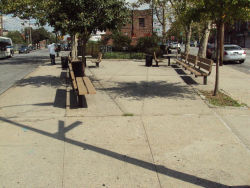Veterans Triangle
Veterans Triangle
The 1936 law naming this triangle states, “the purpose of this resolution is the designation of Veteran Memorial Park to pay tribute to the memory of those who rendered services during the period of national peril.” World War I, which President Woodrow T. Wilson called “the war to end all wars,” cost a total of 8,538,315 lives, 117,000 of which came from the United States, 13,956 from New York State and 7,455 from New York City. This triangle honors those who died in that war.
World War I erupted in the summer of 1914. The nations of Europe formed two Alliances: the Allied powers, led by France and Great Britain, and the Central Powers, led by Germany and Austria-Hungary. In February 1917, after 30 hard fought months, Germany chose to ignore the neutrality of the seas and declared unconditional submarine warfare. Within three weeks, the U.S. formally declared war on the Central Powers. Young American men rushed to enlist and join in the European war effort.
World War I proved to be one of the most static wars in the annals of military history. Both sides endured several years of the engagement in muddy six and half to seven-foot-deep trenches. Men in the trenches suffered under the constant bombardment of shells and the hail of machine gun fire. With both sides dug in, seldom could either successfully advance more than a few yards each day. In 1914, the German army began using chlorine gas to suffocate their enemy, and by 1917, they had advanced to mustard gas, which caused painful and deadly blisters, in the hopes of breaking the stalemate and advancing through the allied French and British lines. In keeping with the escalation of power, the allied forces began to use the technology shortly thereafter.
Although both sides constantly attacked with weapons of mass destruction, the trenches themselves took nearly half of the lives lost in the war. Heavy periods of rain created mud, which made being clean and dry virtually impossible. The water that accumulated in trenches and artillery craters, where soldiers took cover as they advanced, sometimes drowned men where they lay. The perpetual dampness resulted in aptly named cases of “trench foot” where a soldiers’ feet would swell, turn gangrenous, and fall victim to the necessity of amputation or cause the loss of one’s life. Other atrocities of the trench included swarms of lice, dysentery from unsanitary water, a thriving rat population, and effects of the incessant roar of bullets and shells overhead known as shellshock. All these horrors of battle, including having to live with hundreds of rats, steadily wore down the soldier’s morale as the war, which many had claimed would be over in months, dragged into several long years.
The American forces were thrown into the heart of entrenched France. Of the total 364,800 American casualties suffered over the course of the war, 117,000 occurred during Meuse-Argonne offensive, which began in September 1918, and lasted six weeks. World War I, a defining moment in the 20th century forever changed the way the world thought about warfare.
In 1997, Veterans Triangle became part of the Greenstreets program, a collaboration between Parks and the Department of Transportation whose goal is to convert paved street properties into greenspaces. The triangle received site work with $13,201 in funding from Mayor Rudolph W. Giuliani that provided twelve benches, two game tables, and the trees that line the triangle. A multitude of shrubs and flowers, planted in the middle section of the triangle, beautify the sitting area, which is surrounded by a wrought iron fence.
Check out your park's Vital Signs
Clean & Safe
Green & Resilient
Empowered & Engaged Users
Share your feedback or learn more about how this park is part of a
Vital Park System


